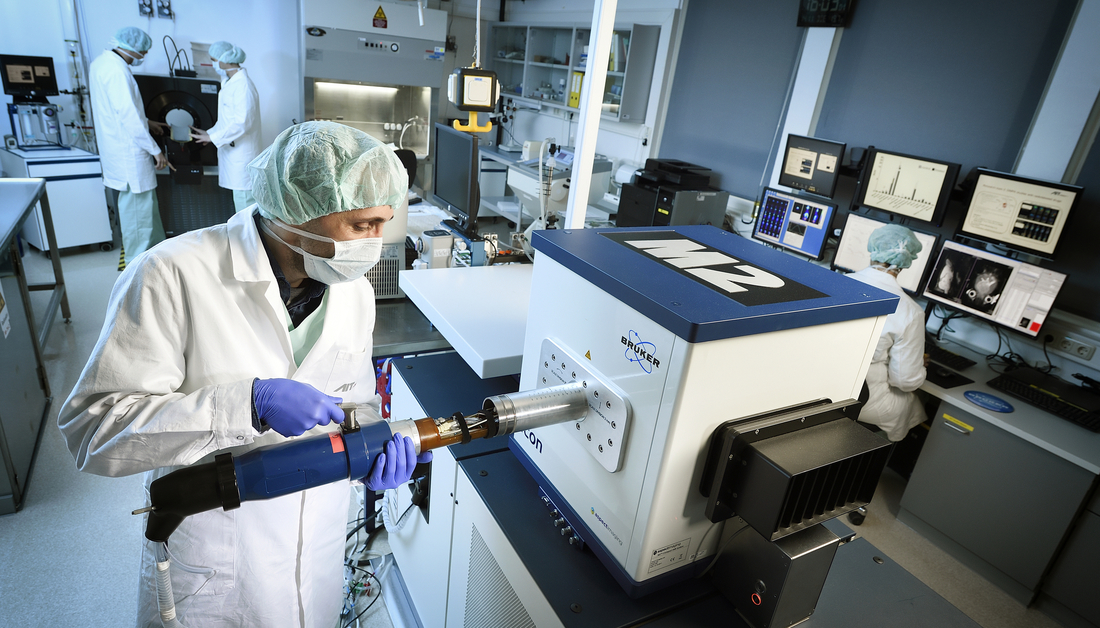Photo (AIT/Zinner): Molecular imaging group
Alzheimer’s disease is a neurodegenerative disease, which mostly affects people over 65 years and leads to dementia. It accounts for up to 60% of 24 million dementia patients per year. Despite intensive research, there is still no effective treatment available yet.
A major hallmark of Alzheimer’s disease are beta-amyloid (Aβ) deposits in the brain leading to neurodegeneration. It has been shown that certain transport proteins in the brain can export toxic Aβ peptides from the brain into the blood acting as a waste disposal system of the brain. As Alzheimer’s disease progresses there is an impairment of the function of these transport proteins, leading to increased Aβ deposition in the brain.
New promising therapeutic approach
These transport proteins form a promising new target for the treatment of Alzheimer’s disease by administering drugs which enhance the activity of transport proteins and thereby promote the elimination of Aβ from the brain. For the development of such drugs methods are needed, which allow for measuring transporter activity in the brain. A very promising method is positron emission tomography (PET), which allows to measure transporter activity non-invasively in the living organism by means of specialized, radioactively labelled substances (so-called PET tracers). PET is of great interest as it allows to rapidly translate preclinical data into patients.
The Preclinical Molecular Imaging group has developed in cooperation with the University of Oslo in Norway and supported by the Austrian Science Fund (FWF) and the Lower Austria Corporation for Research and Education (NFB) novel PET imaging protocols for transport proteins and evaluated these in preclinical Alzheimer’s disease models. These experiments demonstrated that alterations in transporter activity occur in early phases of Alzheimer’s disease. PET imaging of transporter activity can thus be potentially applied for early diagnosis and treatment of Alzheimer’s disease.
These experiments were only possible due to the unique infrastructure at the AIT in Seibersdorf, where a modern, state-of-the-art preclinical imaging laboratory is in close proximity to a radiochemistry laboratory equipped with a cyclotron. Only such a set-up allows to test innovative PET tracers labelled with short-lived carbon-11 (half-life: 20 minutes) in preclinical disease models.
Literature:
Viktoria Zoufal, Thomas Wanek, Markus Krohn, Severin Mairinger, Thomas Filip, Michael Sauberer, Johann Stanek, Jens Pahnke, Oliver Langer. Age dependency of cerebral P-glycoprotein function in healthy and APPPS1 mice measured with PET. J Cereb Blood Flow Metab 2018 Oct 24:271678X18806640. doi: 10.1177/0271678X18806640. [Epub ahead of print]. https://www.ncbi.nlm.nih.gov/pubmed/30354871
Viktoria Zoufal, Severin Mairinger, Markus Krohn, Thomas Wanek, Thomas Filip, Michael Sauberer, Johann Stanek, Claudia Kuntner, Jens Pahnke, Oliver Langer. Measurement of cerebral ABCC1 transport activity in wild-type and APP/PS1-21 mice with positron emission tomography. J Cereb Blood Flow Metab 2019 Jun 13:271678X19854541. doi: 10.1177/0271678X19854541. [Epub ahead of print]. https://www.ncbi.nlm.nih.gov/pubmed/31195936



